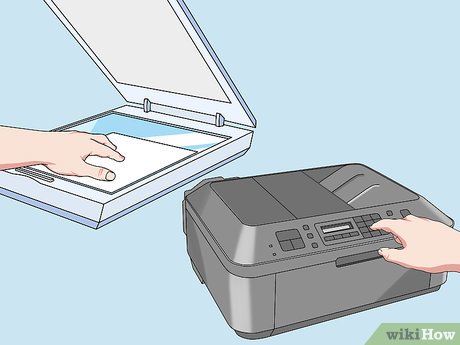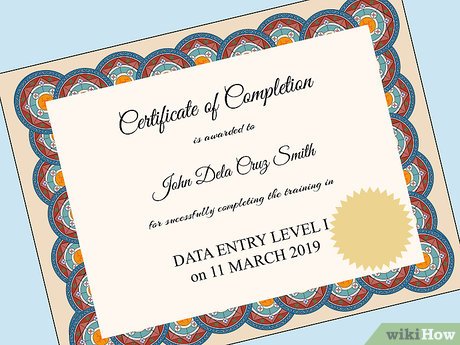How to Learn Data Entry
Method 1 of 2:
Learning the Basics
-
 Practice typing until you reach a speed of at least 30 words per minute. A large portion of data entry work involves typing. This means that being able to type quickly and accurately is essential. The best way to improve your speed is simply to practice typing. Try spending some each day transcribing some written information onto the computer.[1]
Practice typing until you reach a speed of at least 30 words per minute. A large portion of data entry work involves typing. This means that being able to type quickly and accurately is essential. The best way to improve your speed is simply to practice typing. Try spending some each day transcribing some written information onto the computer.[1]- Try to focus on your accuracy when typing, as your speed will naturally increase with practice.
- If you get bored practising, search online for free typing games. These are a fun way to increase your typing accuracy and speed.
- Search online for a typing test to quickly find out how many words per minute you can type.
-
 Take lessons if you aren't confident using a computer. It is really important that you can use easily navigate a computer, as the majority of data entry work is done on a computer. If you aren't confident using a computer, consider asking a friend to give you a few lessons or research basic computer skill courses in your local community.[2]
Take lessons if you aren't confident using a computer. It is really important that you can use easily navigate a computer, as the majority of data entry work is done on a computer. If you aren't confident using a computer, consider asking a friend to give you a few lessons or research basic computer skill courses in your local community.[2]- The ability to use a computer is generally one of the top requirements for data entry employees.
-
 Practice using office equipment, such as printers and scanners. Whilst the majority of your work in a data entry job is on a computer, you will also need to copy and print information. Practice scanning pieces of paper in a scanner and then printing them from your computer.[3]
Practice using office equipment, such as printers and scanners. Whilst the majority of your work in a data entry job is on a computer, you will also need to copy and print information. Practice scanning pieces of paper in a scanner and then printing them from your computer.[3]- Practice using the scanner and printer at your local library or self-service print shop.
-
 Familiarise yourself with basic computer programmes. Data entry jobs primarily use word processing and spreadsheet programmes. Spend some time learning to use the Microsoft Word and Excel or Google Docs and Sheets, as these are the most widely used programmes in businesses. Watch tutorials online, ask a friend to help you, or take a short course.[4]
Familiarise yourself with basic computer programmes. Data entry jobs primarily use word processing and spreadsheet programmes. Spend some time learning to use the Microsoft Word and Excel or Google Docs and Sheets, as these are the most widely used programmes in businesses. Watch tutorials online, ask a friend to help you, or take a short course.[4]- Don't worry about learning complex or company specific database programmes, as this will be taught to you as part of your initiation and training.
-
 Practice your customer service skills. Interacting with customers is an important part of most data entry roles. Practice using a professional tone on the phone, write draft emails to customers, and roleplay a confrontational situation to practice your customer service skills. The more that you practice – the more comfortable you will become.[5]
Practice your customer service skills. Interacting with customers is an important part of most data entry roles. Practice using a professional tone on the phone, write draft emails to customers, and roleplay a confrontational situation to practice your customer service skills. The more that you practice – the more comfortable you will become.[5]- Notice how customer service workers talk to you when you phone up different businesses, such as your power company, gym, or library. Take note of what made you feel valued as a client and then try to imitate those actions.
-
 Ensure that you are able to keep sensitive information confidential. It is essential to realise the importance of confidentiality in data entry roles, as you will often be entering sensitive information, such as people's salaries, the company's profit or loss for the year, or customer's contact details. If you have a habit of sharing information a little too freely, remind yourself of the need for confidentiality often.[6]
Ensure that you are able to keep sensitive information confidential. It is essential to realise the importance of confidentiality in data entry roles, as you will often be entering sensitive information, such as people's salaries, the company's profit or loss for the year, or customer's contact details. If you have a habit of sharing information a little too freely, remind yourself of the need for confidentiality often.[6]- When looking at contracts for data entry jobs look at the confidentiality clauses to remind yourself of your obligations.
Method 2 of 2:
Getting the Right Qualifications
-
 Complete a basic certificate course in data entry to gain basic skills. This is one of the quickest and easiest ways to get learn how to confidently perform a data entry role. These courses normally take between 3 and 12 months to complete and don't tend to have any prerequisites to enter the course. Throughout the course, you will most likely learn how to operate basic computer programmes, improve your typing skills, and practice interacting with customers.[7]
Complete a basic certificate course in data entry to gain basic skills. This is one of the quickest and easiest ways to get learn how to confidently perform a data entry role. These courses normally take between 3 and 12 months to complete and don't tend to have any prerequisites to enter the course. Throughout the course, you will most likely learn how to operate basic computer programmes, improve your typing skills, and practice interacting with customers.[7]- Contact your local tertiary provider to find a suitable course or search online.
- If you don't live close to a data entry course provider, consider completing an online course instead.
-
 Opt for an apprenticeship or internship if you want to learn on the job. If you are willing to learn and have basic computer skills, consider completing a short internship in a data entry role to get some experience. Search online for data entry internships or look in your local newspapers classified section.[8]
Opt for an apprenticeship or internship if you want to learn on the job. If you are willing to learn and have basic computer skills, consider completing a short internship in a data entry role to get some experience. Search online for data entry internships or look in your local newspapers classified section.[8]- If you need to earn money while completing an internship or apprenticeship, confirm with your employer that the position is paid.
-
 Consider completing a business degree to learn a wealth of skills. If you are looking to use data entry as a way to propel yourself into the finance or business industry, think about completing a finance or business degree. This will look great on your resume when you apply for data entry jobs and will also give you a range of other skills and career options.[9]
Consider completing a business degree to learn a wealth of skills. If you are looking to use data entry as a way to propel yourself into the finance or business industry, think about completing a finance or business degree. This will look great on your resume when you apply for data entry jobs and will also give you a range of other skills and career options.[9]- Research and visit the different universities and colleges in your area to decide which one will be the best fit for you.
4.5 ★ | 2 Vote
You should read it
- Check data entry in Excel
- How to limit the value entered by Data Validation Excel
- How to fix '0x00000109: selected entry could not be loaded' on Windows
- Excel data entry faster
- Top 10 best computer junk cleaning software 2021
- How to enter formula data in Excel
- How to Do Qualitative Research
- How to fix 'Access Control Entry Is Corrupt' error on Windows
May be interested
- How to make Excel spreadsheets smarter with drop-down lists
 drop-down lists are your secret weapon against data inconsistencies and typographical errors, making data entry easier and more accurate.
drop-down lists are your secret weapon against data inconsistencies and typographical errors, making data entry easier and more accurate. - Mac Reminders Doesn't Have Quick Entry: Here's the Workaround!
 apple's reminders app is a reliable tool for staying organized, but adding tasks feels slower than it should.
apple's reminders app is a reliable tool for staying organized, but adding tasks feels slower than it should. - What is Data Scientist? How to become Data Scientist?
 data scientist is the most sexy profession of the 21st century, according to harvard business review. with intensive skillset and spread across many fields, data scientist is also considered 'rare as unicorn'.
data scientist is the most sexy profession of the 21st century, according to harvard business review. with intensive skillset and spread across many fields, data scientist is also considered 'rare as unicorn'. - How to remove periods in numbers in Excel
 how to remove periods in numbers in excel when typing a string of numbers, data entry people have a habit of inserting dots in the middle to easily observe the data and reduce errors when entering data. however, in some cases, the dot will make the calculation impossible.
how to remove periods in numbers in excel when typing a string of numbers, data entry people have a habit of inserting dots in the middle to easily observe the data and reduce errors when entering data. however, in some cases, the dot will make the calculation impossible. - How to fix 'Access Control Entry Is Corrupt' error on Windows
 if something corrupts the acl, you may get the 'access control entry is corrupt' error when trying to access certain resources on windows.
if something corrupts the acl, you may get the 'access control entry is corrupt' error when trying to access certain resources on windows. - How to create a newline in Excel 2020
 simple way down line in excel 2020. during data entry in excel, there is much longer content than the width of the cell, so the data is overflowed to other cells. so you want to go down the line so that the data is displayed in a full cell, help ch
simple way down line in excel 2020. during data entry in excel, there is much longer content than the width of the cell, so the data is overflowed to other cells. so you want to go down the line so that the data is displayed in a full cell, help ch - How to turn on Siri iOS 11 control content entry mode
 controlling siri through content entry is a new point on ios 11 version announced by apple at wwdc 2017 event.
controlling siri through content entry is a new point on ios 11 version announced by apple at wwdc 2017 event. - How to Redo Typing in Windows
 many know to press when they want to 'undo' their last entry. but, what if you press 'undo' by accident? fortunately, you can revert to your last entry by using the 'redo' command. 'redo' is a fast and easy way to undo the 'undo' you did...
many know to press when they want to 'undo' their last entry. but, what if you press 'undo' by accident? fortunately, you can revert to your last entry by using the 'redo' command. 'redo' is a fast and easy way to undo the 'undo' you did... - Types of data center design
 it professionals always have to learn, apply new ways to design the data center structure to get efficiency, ensure large capacity and easily expand without any trouble.
it professionals always have to learn, apply new ways to design the data center structure to get efficiency, ensure large capacity and easily expand without any trouble. - How to create drop down lists in Excel
 how to create drop down lists in excel. to limit the typing of misspelled data and the same information but the data is not identical due to the person entering at uppercase, sometimes lowercase or extra spaces that make the statistics error, therefore, when designing a data entry, every employe
how to create drop down lists in excel. to limit the typing of misspelled data and the same information but the data is not identical due to the person entering at uppercase, sometimes lowercase or extra spaces that make the statistics error, therefore, when designing a data entry, every employe














 How to Create a Database from an Excel Spreadsheet
How to Create a Database from an Excel Spreadsheet How to Keep and Control Records Using Microsoft Access
How to Keep and Control Records Using Microsoft Access How to Disable Microsoft Security Essentials
How to Disable Microsoft Security Essentials How to Link Tables in Access
How to Link Tables in Access How to Use Microsoft Access
How to Use Microsoft Access To learn about SQL and databases, do not ignore these 23 online resources
To learn about SQL and databases, do not ignore these 23 online resources